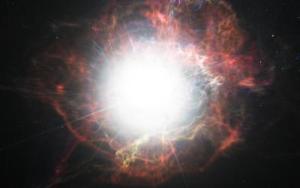Jul 11 2014
The origin of cosmic dust in galaxies is still a mystery [1]. Astronomers know that supernovae may be the primary source of dust, especially in the early Universe, but it is still unclear how and where dust grains condense and grow.
 This artist's impression shows dust forming in the environment around a supernova explosion. VLT observations have shown that these cosmic dust factories make their grains in a two-stage process, starting soon after the explosion, but continuing long afterwards. Credit: ESO/M. Kornmesser
This artist's impression shows dust forming in the environment around a supernova explosion. VLT observations have shown that these cosmic dust factories make their grains in a two-stage process, starting soon after the explosion, but continuing long afterwards. Credit: ESO/M. Kornmesser
It is also unclear how they avoid destruction in the harsh environment of a star-forming galaxy. But now, observations using ESO's VLT at the Paranal Observatory in northern Chile are lifting the veil for the first time.
An international team used the X-shooter spectrograph to observe a supernova — known as SN2010jl — nine times in the months following the explosion, and for a tenth time 2.5 years after the explosion, at both visible and near-infrared wavelengths [2]. This unusually bright supernova, the result of the death of a massive star, exploded in the small galaxy UGC 5189A.
"By combining the data from the nine early sets of observations we were able to make the first direct measurements of how the dust around a supernova absorbs the different colours of light," said lead author Christa Gall from Aarhus University, Denmark. "This allowed us to find out more about the dust than had been possible before."
The team found that dust formation starts soon after the explosion and continues over a long time period. The new measurements also revealed how big the dust grains are and what they are made of. These discoveries are a step beyond recent results obtained using the Atacama Large Millimeter/submillimeter Array (ALMA), which first detected the remains of a recent supernova brimming with freshly formed dust from the famous supernova 1987A (SN 1987A; eso1401).
The team found that dust grains larger than one thousandth of a millimetre in diameter formed rapidly in the dense material surrounding the star. Although still tiny by human standards, this is large for a grain of cosmic dust and the surprisingly large size makes them resistant to destructive processes. How dust grains could survive the violent and destructive environment found in the remnants of supernovae was one of the main open questions of the ALMA paper, which this result has now answered — the grains are larger than expected.
"Our detection of large grains soon after the supernova explosion means that there must be a fast and efficient way to create them," said co-author Jens Hjorth from the Niels Bohr Institute of the University of Copenhagen, Denmark, and continued: "We really don't know exactly how this happens."
But the astronomers think they know where the new dust must have formed: in material that the star shed out into space even before it exploded. As the supernova's shockwave expanded outwards, it created a cool, dense shell of gas — just the sort of environment where dust grains couldseed and grow.
Results from the observations indicate that in a second stage — after several hundred days — an accelerated dust formation process occurs involving ejected material from the supernova. If the dust production in SN2010jl continues to follow the observed trend, by 25 years after the supernova, the total mass of dust will be about half the mass of the Sun; similar to the dust mass observed in other supernovae such as SN 1987A.
"Previously astronomers have seen plenty of dust in supernova remnants left over after the explosions. But they also only found evidence for small amounts of dust actually being created in the supernova explosions. These remarkable new observations explain how this apparent contradiction can be resolved," concludes Christa Gall.